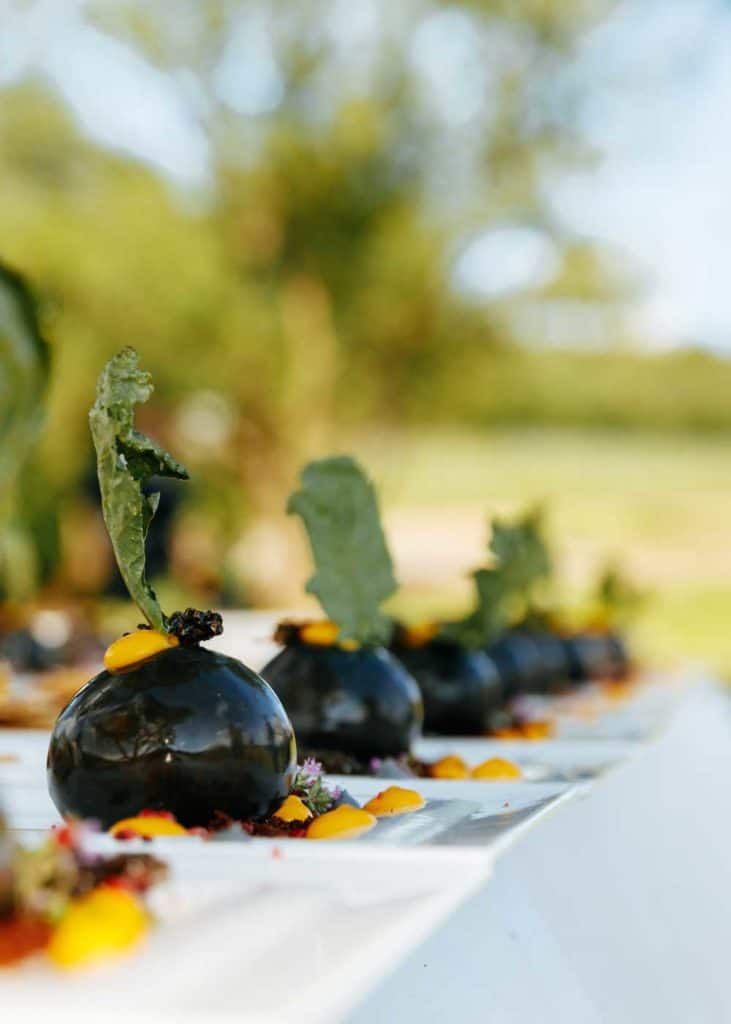What is the field-to-table concept? Field to table, farm to table, or farm-to-fork are all similar phrases for the same idea. That our food should be grown at home, or at least by our local farmer, with as few road and air miles as possible and with limited poisons, toxins, or pesticides. There are numerous ways to support this movement.

In this guide, you’ll learn the definition of farm to table, why it matters, and how to support the field to table movement. Plus numerous resources to learn about and participate in farm-to-table dining.
Table of Contents
Farm to Table Guide
Since the 1940’s we have been steadily moving away from the concept of home-grown and enjoyed. In the journey toward apparent ‘modernity’, we have embraced pesticides, toxins, and other non-organic approaches to farming.
Very few of us now grow our own vegetables. This steady decline away from natural practices has been like the boiled frog to food, as we have migrated away from what is organic, toward what is largely unnatural.
But that is beginning to change! With the 1990s came the notion of slow food, slow movement, and organic local food from farmers’ markets.
Words like ‘plant based’, ‘plant centric’, and ‘vegetable forward’ became part of the restaurant lexicon. We now find ourselves in a new era of food consumption, and it doesn’t get much better than this!!
What is Farm to Table?
Farm to table is a recent social movement focused on consumers directly acquiring local food from the producer. While often thought of as produce and meat, it also includes fisheries, wineries and breweries, and other non-traditional “farms” or food producers.
3 Ways to Support Farm to Table
Consumers can support field-to-table distribution in many ways.
- Farmers Market: Today, even most small towns have a local farmer’s market. We support our farmer’s market, both by shopping in person and by purchasing directly from the farmers that display there.
- Community-Supported Agriculture (CSA Model): This system of crop sharing subscription connects consumers and local producers that allows shared farming risks across both segments.
- Local Restaurants and Distribution: Because of its popularity, local produce and food have become a unique selling proposition. Supermarkets and restaurants proudly display products and dishes sourced locally.
How Common is the Local Food Movement? In 2015, the US-based National Restaurant Association identified 4 of the top 10 food trends to be local food-related, according to Havard University and the Culinary Institute of America.
What is Another Name for Farm to Table?
The Farm to Table concept is known by many names. These include:
- Field to table
- Farm to fork
- Farm to table
- Farm to school
- Field to fork
- Sustainable agriculture
- Low-carbon diet
- Similar concepts include Slow food, food miles, kitchen garden, bean to bar (chocolate), organic farming, and food traceability (knowing where your food comes from).
In the United Kingdom, initiatives like IKnowFood addressed food system resilience and addressed field-to-table concepts.
The IKnowFood project was “led by Professor Bob Doherty (The York Management School and the York Environmental Sustainability Institute YESI) with collaborators from the University of York and the Universities of Liverpool and Manchester. The project was funded by the Global Food Security Programme.” ~ IKnowFood.org

Why Does Field to Table Matter?
A century ago, movements like farm-to-fork or farm-to-table, or even organic simply didn’t exist! Why? Because all food was naturally pesticide-free, local, and non-toxic.
Over time, we have moved away from this concept, but the people have spoken and the demand for locally produced, healthy food is at an all-time high.
Field to table matters, because we want to know where our food has come from. This information assures us that it is either organic or at least much closer to nature than what we can find in our supermarkets.
Farm-to-table food generally travels far fewer miles, and it also helps us establish a relationship and a connection with our farmers and local food suppliers.
Field-to-table food is local to your dining table and so much healthier for you, your family, and your loved ones. Consumers have recently shown that they will pay more for food that is from a known location and where animals are free-range and vegetables are organically grown.
The focus here is on seasonal food that is lovingly prepared. Read on for how restaurants are creating amazing dishes using ‘nose to tail’ approaches and getting back to basics with cooking methods that honor the seasons.
A result of the deviation from traditional growing methods has resulted in an increase of food sensitivities and allergies. Here’s how pervasive a corn allergy can be.
How to Enjoy Field to Table
With changes in attitudes toward sourcing our food and an overall trend to slow down, be healthier and deal more directly with the people that supply our food. The next logical step is for more and more restaurants to open up that celebrate the field to fork concept for you to enjoy.
You can also start to bring more farm-to-table to your cooking at home! There are plenty of blogs, cookbooks, and websites dedicated to helping you create healthy, delicious, and sustainable food.
If your goal is to embrace the field-to-table philosophy, you can start by making local food a priority. You can also try to grow your own food at home, even if you start with a herb garden or sprouting seeds, which take up very little space.
Another way to kick-start change is to start making your own bread. This is an affordable way to start making farm-to-table improvements to your culinary skills.
Search out your local farmer’s markets, or hunt out local farms, where you can buy direct from the farmer. You will be so surprised at how easy it is to make small changes to your approach to sourcing and preparing your food. You will wonder how you ever lived a different way!
Knowing that you are helping your health and those who share your table, and the planet are all great reasons for supporting the farm-to-table approach. Read on to find out where you can learn more about this amazing concept.
Where Can I Learn More?
Want to try your hand at cooking farm-to-table recipes at home? Check out recipe books and websites geared towards clean, sustainable eating.
4 Farm to Table Books: Guides and Cookbooks
- Farm to Table: Essential Guide to Sustainable Food Systems for Students, Professionals, and Consumers
- Before We Eat: From Farm to Table (For Kids)
- Farm to Table Desserts: 80 Seasonal Recipes
- Taste of Home: Farm to Table Cookbook
Recipe books help you make the most of your garden and homemade produce so that you can bring your field into your kitchen.
If you don’t have a garden of your own, you can check out local farmers’ markets and grocery shops. By shopping and eating locally, you can be happy that you’re supporting your community and eating farm-to-table.
Farm to Table Blogs
Not sure what to do with all of your produce? Try self-sufficient tips and tricks outlined in online blogs.
You can find information about canning using your farm-to-table homesteading techniques.
- Dishing Up The Dirt (Andrea Bemis)
- Farm to Table: Canning and Recipes for Summertime Family Gardening Fun (Hadley Court)
- Farm to Table and Everything in Between (Inquiring Chef)
- Here’s the Deal with Farm-to-Table (Food Network)
If social media is more your thing, influencers who are leading the way with the field to farm movement include Instagram’s @farmtotablela and blogger and farm-fresh-foodie Luise Vindhal.
Luise and her family live in Stockholm and live off healthy simple vegetarian food with natural whole grains and vegetables. She is a qualified Holistic Nutritional Therapist with 3 ‘wild and vegetable loving’ children.
With no end of resources to help you live the field to fork lifestyle, what are you waiting for?!
Using the Farm-to-Table Phrase Correctly
In this article, we have used ‘Field to Table,’ ‘Farm to Table,’ and ‘Fork to Table’ interchangeably. They are all similar phrases with the same end goal.
But be careful. Due to the popularity of this movement, food labels have become increasingly difficult to understand. Words like ‘wild-caught’ or ‘farm-fresh’ and ‘farm-raised’ make it really hard to know exactly what and where your food has come from.
How can you verify the authenticity of a product? Anyone selling or serving it to you should be able to tell you the specific farm from which it was sourced. And it’s totally okay to ask questions!

Learn more about washing and storing blackberries.
Wrap Up
So, what’s next? You should source and locate your local farmer’s markets and farm-to-table restaurants near you and start to support the movement! With a little bit of research, you can support field-to-table businesses and begin incorporating local goods to your lifestyle.
- About the Author
- Latest Posts
Bryan Haines is a co-founder and writer on Tasty Plate – and is working to make it the best food blog in the world.
While living in South America, Bryan enjoyed learning about new foods and preparation methods. Back in Nova Scotia, he enjoys growing food in the backyard. And then preparing it with traditional (and non-traditional) methods and ingredients.
He is also co-founder of Storyteller Media, a company he started with his wife, Dena.

